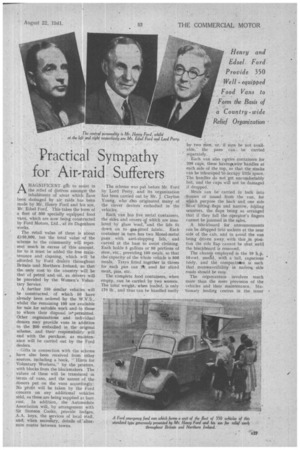Practical Sympathy for Air-raid Sufferers
Page 37

Page 38

If you've noticed an error in this article please click here to report it so we can fix it.
AMAGNIFICENT gift to assist in the relief of distress amongst the inhabitants of areas which nave been damaged by air raids has been made by Mr. Henry Ford and his son, Mr. Edsel Ford. This takes the formof a fleet of 350 specially equipped food vans, which are now being constructed by Ford Motors, Ltd., at its Dagenham works.
The retail value of these is about £150,000, but the total value of the scheme to the community will represent much in excess of this amount, for to it must be added the free maintenance and cleaning, which will be afforded by Ford dealers throughout Britain and Northern Ireland, so that the. only cost to the country will be that of petrol .and. oil, as drivers will be provided by the Women's Voluntary Service.
A further 150 similar vehicles will be constructed, of which SO have already been Ordered by the W.V.S., whilst the remaining 100 are available for sale for suitable work and to those to Whom their disposal is permitted. Other organizations and. individual donors may provide vans in addition to the $50 embodied in the original scheme, and their responsibility will end with the purchase, as maintenance will be carried out by the Ford dealers.
• Gifts in connection with the scheme have also been received from other sources, including a book, " Hints for Voluntary Workers," by the printers, with blocks from the blockma.kers. The values of these will be translated in terms of vans, and the names of the donors put on the vans accordingly: No profit will be taken by the Ford concern on any additional vehicles Mild, as these are being-supplied at bare cost. In addition,. the Automobile Association will, by arrangement with Sir Stenson Cooke, provide badges. A.A. keys, the services of local staff, and, when necessary, details of 'alternate routes between towns.
The scheme was put' before Mr. Ford by Lord Perry, and its organization has been carried out by Mr, J. Clayton Young, who also originated many of the clever devices embodied in the vehicles.
Each van has five metal containers, the sides and covers of which are insulated by glass wool,*and. the lids fit down on to gas-proof fabric. Each container in turn has two Monel-metal pans with anti-slopping lids, and curved at the base to assist cleaning. Each holds5 gallons or 80 portions of Stew, etc., providing 160 meals, so that the: capacity of the whole vehicle is 800 meals. Trays fitted together in threes for each pan can 1% used for sliced meat, pies, etc.
The complete food containers, when empty, can be carried by two women. The total weight, when loaded, is only 170 lb., and thus can be handled easily
by two men, or,if Men be not available, the pans , can. be carried separately.
Each van also carries containers for, 200 cups, these havingkwire handles at each side of the top, so that the stacks can be telescoped to occupy little space. The handles do not: get uncomfortably hot, and the cups will not be damaged if dropped.
Meals can be carried in bulk into houses or issued from the van, for which purpose the back and one side have lifting_ flaps and narrow, folding counters, the flaps being so arranged that if they fall the operator's fingers cannot be jammed in the sides.
A blackboard for announcements can be &ripped into sockets at the near side of the cab, and to avoid the van being driven away with this _in position the side flap cannot be shut until the blackboard is removed, The chassis employed is the 10 h,p. 10-cwt. mocrel, with a tall, capacious body, and the compactness is such that manceuvrability in nairoa& side roads should be easy.
The organization involves much mofe than the mere provision of the vehicles and their maintenance. Stationary. feeding centres in the inner
areas lose their value to a large extent when people temporarily leave their homes at such points and migrate to outer aieas, and it is at these times that mobility counts. Many of the residents soon return and might, in the ordinary way, have to subsist for a time on tinned food, etc., failing adequate facilities for cooking. Thefefore, the idea is to employ decentralized kitchens from which the vans will radiate to the districts where meals are necessary, or they Could be directed into the centre when required. . Dealers' at specific points in each area have been selected, and each will house a certain numbet of the vehicles. These can be sent frem one town to another in case of emergency, each van having a range of mere than 50 miles, whilst the areas have been selected so that no town or village in any vulnerable area Twill be outside the scope of the plan. The vans will Operate in conjunction with the Ministry of Food and local autligrities, who will be responsible for prosTiling food when • necessary The food can be kept hot for at least three hours, and the primary idea is to supply hot food to a large number of people who a,re still able to remain in their own homes, and the service can be confirmed until means for cooking are restored.
Another idea is to employ the vehicle for use between works canteens which are in operation and those which may have broken down as a result of enemy action. A further facility, which can be offered is the provision of meals at temporary rest centres.




























































